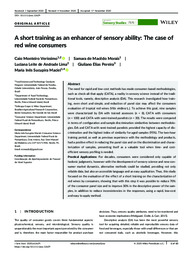A short training as an enhancer of sensory ability: the case of red wine consumers.
A short training as an enhancer of sensory ability: the case of red wine consumers.
Autoria: VERÍSSIMO, C. M.; MORAIS, S. de M.; LIMA, L. L. de A.; PEREIRA, G. E.; MACIEL, M. I. S.
Resumo: The need for rapid and low-cost methods has made consumer-based methodologies, such as check-all-that-apply (CATA), a reality in sensory science instead of the traditional tools, namely, descriptive analysis (DA). This research investigated how training, even short and simple, and reduction of panel size may affect the consumers evaluation of tropical red wines (Vitis vinifera L.). To achieve this goal, nine samples were characterized by DA with trained assessors (n = 8), CATA with consumers (n = 100) and CATA with semi-trained panelists (n = 30). The results were compared in terms of configuration and sample discrimination similarities between methodologies. DA and CATA with semi-trained panelists provided the highest capacity of discrimination and the highest index of similarity for aged samples (95%). The two-hour training period, as well as previous experience with the methodology and products, had a positive effect in reducing the panel size and on the discrimination and characterization of samples, presenting itself as a valuable tool when time- and costefficient sensory profiling is needed. Practical Applications: For decades, consumers were considered only capable of hedonic judgments, however with the development of sensory science and new consumer market dynamics, alternative methods could be studied, providing not only reliable data, but also an accessible language and an easy application. Thus, this study focused on the evaluation of the effect of a short training on the characterization of red wines by consumers, showing that with this step it was possible to reduce 70% of the consumer panel size and to improve 30% in the descriptive power of the samples, in addition to reduce inconsistencies in the responses, using a rapid, low-cost and easy to apply method.
Ano de publicação: 2020
Tipo de publicação: Artigo de periódico
Unidade: Embrapa Uva e Vinho
Palavras-chave: Check-all-that-apply (CATA), Consumers, Descriptive analysis (DA), Red wine consumers, Red wines, Vitis Vinifera, Wines
Observações
1 - Por padrão são exibidas publicações dos últimos 20 anos. Para encontrar publicações mais antigas, configure o filtro ano de publicação, colocando o ano a partir do qual você deseja encontrar publicações. O filtro está na coluna da esquerda na busca acima.
2 - Para ler algumas publicações da Embrapa (apenas as que estão em formato ePub), é necessário ter, no celular ou computador, um desses softwares gratuitos. Sistemas Android: Google Play Livros; IOS: iBooks; Windows e Linux: software Calibre.
Acesse outras publicações
Acesse a Base de Dados da Pesquisa Agropecuária (BDPA) para consultar o acervo completo das bibliotecas da Embrapa.

